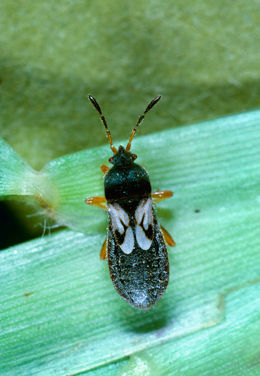Recognize Risks for Chinch Bug
December 13, 2018

Native to North America, chinch bugs (Blissus leucopterus spp.) are occasional insect pests that possess the capability to wipe out cultivated grass crops, especially corn and grain sorghum. Chinch bugs can be found from the East Coast to the Western Plains states. Broadleaf plants such as soybeans are naturally immune to feeding damage from chinch bugs. Typically, chinch bug infestations occur during dry weather in spring and early summer.
Below-normal moisture and above-normal temperatures from March to October can also lead to chinch bug problems in the Southeast.
Identification and Lifecycle
The adult chinch bug is about 3/16 inches long, with white-patched wings and a black body. Nymphs are reddish-orange with a white band across their backs. Later instar nymphs turn darker, and resemble adults as they mature. When the bugs are crushed, they emit an unpleasant odor.
Adults overwinter in crop residue as well as in weeds and wild grasses, moving into fields to feed on young corn plants during dry weather. In the spring, adults lay eggs first on small grain crops. Chinch bugs produce two to three generations per year, and the later generations move to corn plants.
Crop Damage
Both adults and nymphs damage the plant by piercing it and sucking the plant juices. The leaves on damaged corn plants may be rolled and appear purple in color. Extensive feeding causes plants to wilt; seedlings may die. Plants that survive heavy infestations are stunted and will develop slowly, delaying maturity. The result can be lodging, dwarfing and yield loss.
This pest is more likely to cause problems in dry years with heavy populations. Seedling plants are most susceptible to injury.
Scouting
Begin scouting for chinch bugs as soon as seedlings emerge. Look for chinch bugs behind the leaf collar or around the base of the corn plant. During drought conditions, check the edges of corn fields, especially those near mature or harvested small grains. Judge the percentage of plants infested and sample to determine if damage is reaching economic thresholds. Refer to university Extension weekly and monthly reports for scouting guidelines and economic thresholds for insecticide treatments in specific corn-growing geographies.
Best Management Practices to Control Chinch Bug
In no-till or limited-till situations, chinch bugs may become established in the soil, overwinter and feed on newly planted seedlings. For best results in managing chinch bugs, remove existing crop residue and control weeds through tillage, a burndown herbicide and residual preplant herbicides.
Taking out existing vegetation prior to planting will also provide better penetration of insecticide spray or granules. Season-long weed control helps prevent chinch bugs from causing crop damage and harming yields and will help improve effectiveness of in-season insecticide treatments. Crop rotation continues to be one of the most economical and effective cultural practices for controlling a wide variety of crop pests. Rotation to a broadleaf crop such as soybeans is helpful for controlling chinch bugs.
The best approach to managing chinch bugs in corn is prevention. Bayer CropScience offers season-long insect pest control options from seed treatments to foliar applied products.
Hybrids and seed traits
Farmers should consult with their seed dealer and review university Extension field trials to evaluate Bt corn and non-Bt hybrid options to control chinch bugs.
Seed treatments
Starting off with a good seed treatment is an excellent way to control insects and protect corn plants above and below the ground. Under low-to-moderate pest pressure, seed treatments labeled for chinch bugs will go a long way to protect young seedlings from damage.
Insecticides
Apply insecticide when plants are less than 6 inches tall or when a sample of at least 20 percent of plants show five or more chinch bugs. Baythroid® XL insecticide, a pyrethroid, performs on a broad spectrum of corn insect pests, with fast knockdown and long residual control. Always manage insecticide resistance by rotating different classes of chemistries with different modes of action in combination with other control practices.
Always read and follow label instructions. Not all products are registered for use in every state. Baythroid XL is a Restricted Use Pesticide.